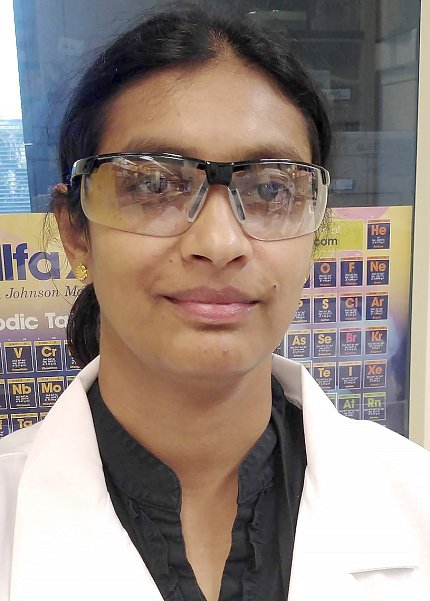Intramural Inventor Series Returns
Making New Molecules for New Uses

In celebration of Makers Month, the NIH Record introduces some intramural inventors.
Reverse munchies? That’s what Dr. Malliga Iyer, principal investigator and acting chief of the section on medicinal chemistry (SMC) at the National Institute on Alcohol Abuse and Alcoholism (NIAAA), wanted to make as she pondered how to develop a drug to treat obesity and associated diseases (also known as metabolic syndrome disorders).
Iyer is a medicinal chemist, someone trained to design and synthesize molecules to create new drugs or improve existing ones. Her lab studies drug targets in the endocannabinoid system, with the goal of designing medications that could be used for treating obesity, diabetes, fibrosis and alcohol use disorders (AUDs).
The human body naturally produces endocannabinoids, which are named for their ability to induce effects mimicking the cannabinoid molecules found in the marijuana plant. These endocannabinoids regulate and control many vital bodily functions.
“We are looking at treating effects that are similar to those arising from marijuana consumption,” explained Iyer. One such effect, the “munchies,” occurs when certain compounds in marijuana (tetrahydrocannabinol–THC) activate signaling of a protein (receptor) in the hypothalamus called CB1. Overactivation of CB1causes an increased appetite, especially for palatable, highly processed foods and is also implicated in many pathological conditions.
Iyer wanted to “flip [this process] to use as an obesity treatment that would make people want to eat less.”
Tamping down the CB1 overactivation offers opportunities to treat multifactorial diseases, or diseases that are influenced by both genetic and environmental factors. Thus far, attempts to make a CB1 antagonist have had mixed success due to unwanted side effects such as anxiety and suicidal ideation. Years of subsequent research showed that if the CB1 antagonist can exert its action away from the brain, it may offer renewed hope for treating multifactorial diseases with fewer side effects.
Iyer’s lab is interested in developing safer and more efficacious drugs using a ‘designed multi-target approach,’ which seeks to synthesize safer CB1 antagonist molecules that would suppress appetite and ameliorate associated diseases, all without the malaise seen from previous brain-penetrant drugs. Iyer has designed and synthesized two such molecules: MRI-1867 and MRI-1891, which ultimately became Zevaquenabant and Monlunabant. These compounds have shown to be effective in treating obesity, diabetes and multiple organ fibrosis in animal models and are now candidates in human trials.
Other areas of interest for her lab include ways to make chemistry more environmentally friendly and improve the efficiency of the molecule synthesis process.
“We are interested in developing [methods for making chemical compounds] that are green and sustainable,” she explained.

Photo: TRIFF/SHUTTERSHOCK
Such methods could include minimizing use of hazardous solvents, utilizing benign reagents or even patenting new techniques to replace less efficient ones.
Iyer also sees opportunities for using artificial intelligence (AI) and deep learning to reduce the time it takes to go from designing a molecule to making a functional drug product. Sometimes the process requires making hundreds of molecules before finally landing on the right candidate, she said.
“Could we utilize AI to give us more knowledge-based decision making and take compounds to clinic [sooner]?”
Even as Iyer’s lab monitors whether their CB1 molecules reduce food intake, she and her colleagues are also looking to apply their development approaches to broader use. Iyer envisions a “single pill to treat many diseases.”
This story is part of an ongoing series on NIH Makers.
